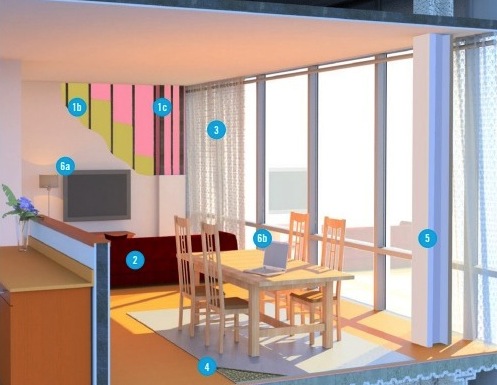Global architecture and design firm Perkins+Will has released new research in response to the need for architects and interior designers to develop a better understanding of flame retardants and their impact on health.
The white paper, “Healthy Environments: Strategies for Avoiding Flame Retardants in the Built Environment,” was developed by Perkins+Will’s Healthy Materials Group and Science Fellow Michel Dedeo. It identifies both new and existing opportunities to design healthier buildings without compromising fire safety or code compliance.
Flame retardants in the built environment are associated with a range of health impacts including cancer, endocrine disruption, and neurodevelopmental problems. Many flame retardants are persistent, bioaccumulative, and/or toxic, and their use in buildings is largely avoidable.
Perkins+Will’s white paper includes a list of 193 flame retardants, including 29 discovered in building and household products, 50 discovered in the indoor environment, and 33 discovered in human blood, milk, and tissues.
The research can help designers identify which products should be subjected to extra scrutiny during the design and construction process and provides options for less hazardous alternatives. The white paper also helps to identify gaps in current understanding of the sources and paths of chemical exposure.
“We want to bring awareness to this important issue impacting the health and wellbeing of building occupants,” said Perkins+Will’s Healthy Materials Leader Suzanne Drake. “The research we have conducted is a valuable resource for identifying healthy alternatives to flame retardant building materials.”
Related Stories
Building Materials | Oct 2, 2023
Purdue engineers develop intelligent architected materials
Purdue University civil engineers have developed innovative materials that can dissipate energy caused by various physical stresses without sustaining permanent damage.
Products and Materials | Sep 29, 2023
Top building products for September 2023
BD+C Editors break down 15 of the top building products this month, from smart light switches to glass wall systems.
Giants 400 | Aug 22, 2023
Top 115 Architecture Engineering Firms for 2023
Stantec, HDR, Page, HOK, and Arcadis North America top the rankings of the nation's largest architecture engineering (AE) firms for nonresidential building and multifamily housing work, as reported in Building Design+Construction's 2023 Giants 400 Report.
Giants 400 | Aug 22, 2023
2023 Giants 400 Report: Ranking the nation's largest architecture, engineering, and construction firms
A record 552 AEC firms submitted data for BD+C's 2023 Giants 400 Report. The final report includes 137 rankings across 25 building sectors and specialty categories.
Giants 400 | Aug 22, 2023
Top 175 Architecture Firms for 2023
Gensler, HKS, Perkins&Will, Corgan, and Perkins Eastman top the rankings of the nation's largest architecture firms for nonresidential building and multifamily housing work, as reported in Building Design+Construction's 2023 Giants 400 Report.
Standards | Jun 26, 2023
New Wi-Fi standard boosts indoor navigation, tracking accuracy in buildings
The recently released Wi-Fi standard, IEEE 802.11az enables more refined and accurate indoor location capabilities. As technology manufacturers incorporate the new standard in various devices, it will enable buildings, including malls, arenas, and stadiums, to provide new wayfinding and tracking features.
Architects | Jun 6, 2023
Taking storytelling to a new level in building design, with Gensler's Bob Weis and Andy Cohen
Bob Weis, formerly the head of Disney Imagineering, was recently hired by Gensler as its Global Immersive Experience Design Leader. He joins the firm's co-CEO Andy Cohen to discuss how Gensler will focus on storytelling to connect people to its projects.
Digital Twin | May 8, 2023
What AEC professionals should know about digital twins
A growing number of AEC firms and building owners are finding value in implementing digital twins to unify design, construction, and operational data.
Design Innovation Report | Apr 27, 2023
BD+C's 2023 Design Innovation Report
Building Design+Construction’s Design Innovation Report presents projects, spaces, and initiatives—and the AEC professionals behind them—that push the boundaries of building design. This year, we feature four novel projects and one building science innovation.
Airports | Apr 18, 2023
India's mammoth new airport terminal takes ‘back to nature’ seriously
On January 15, 2023, Phase 1 of the Kempegowda International Airport’s Terminal 2, in Bengaluru, India, began domestic operations. The 2.75 million-sf building, designed by Skidmore, Owings & Merrill (SOM), is projected to process 25 million passengers annually, while providing its travelers with a healthier environment, thanks to extensive indoor-outdoor landscaping that offers serenity to what is normally a frenzied experience.

















